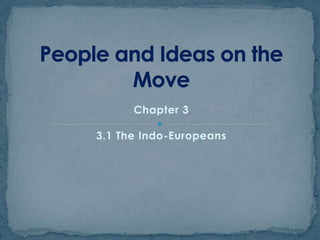
3.1 the indo europeans
- 1. Chapter 3 3.1 The Indo-Europeans
- 2. The Indo-Europeans were a group of semi- nomadic peoples who came from the steppes—dry grasslands that stretched north of the Caucasus Mountains, which lie between the Black and Caspian seas. Map These primarily pastoral people herded cattle, sheep, and goats. The Indo-Europeans also tamed horses and rode into battle in light, two- wheeled chariots. They lived in tribes that spoke forms of a language that we call Indo-European.
- 3. The languages of the Indo-Europeans were the ancestors of many of the modern languages of Europe, Southwest Asia, and South Asia. English, Spanish, Persian, and Hindi all trace their origins back to different forms of the original Indo- European language.
- 4. No one is for sure why the Indo-Europeans left their land. Dried lands? Over population? Escape from invaders? Disease? Whatever the reason, the Indo-Europeans began migrating to other regions over the next 500 years.
- 6. By about 2000 BC, one group of Indo-European speakers, the Hittites, occupied Anatolia, also called Asia Minor. Huge peninsula in modern-day Turkey that juts out into the Black and Mediterranean seas. high, rocky plateau, rich in timber and agriculture. The city of Hattusas was its capital. The Hittites adopted and adapted: Used their own language with one another. Adopted the Babylonians language, Akkadian. Borrowed literature, politics, and laws ideas from the Mesopotamians.
- 7. The Hittites were superior in war because of their advanced technology The Chariot Iron instead of Bronze However, they were overrun and conquered by tribes from the North and vanished around 1190 BC
- 8. At the same time of the Hittites, another Indo- European people, the Aryans, crossed over the northwest mountain passes into the Indus River Valley of India. The only records they left were their sacred literature, the Vedas, which gives a fairly accurate picture of Aryan life. The Vedas are four collections of prayers, magical spells, and instructions for performing rituals. At first, the Vedas were not written, but passed down orally. However, the Aryans believed reciting the prayers incorrectly would have terrible consequences.
- 9. The Aryans (“the nobles” in their language) called the people they found in India dasas (“dark”), referring to the color of their skin. (Dasa eventually became the Aryan word for slave.) The Aryans differed from the dasas in many ways. Aryans were taller, lighter in skin color, and spoke a different language. The Aryans had not developed a writing system. They were pastoral people and counted their wealth in cows. The dasas, on the other hand, were town dwellers who lived in communities protected by walls.
- 10. Aryans were divided into four groups or social classes according to their occupation: Brahmins (priests) Warriors Traders and landowners peasants or laborers. The class that an Aryan belonged to determined his or her role in society.
- 11. (landowners and traders) (priests) (rulers and warriors) (Laborers and peasants)
- 12. At first, the four classes mixed freely. Eventually, the higher groups began to exclude the lower classes. The Shudras (laborers or craftsmen) did the work that Aryans did not want to do. Varna, or skin color, was the distinguishing characteristic in this system. People are born into their caste for life. Their caste membership determined the work they did the man or woman they could marry the people with whom they could eat. Ritual purity was all-important in Aryan culture. The jobs that would make a person unclean (grave digging, butchers, trash collectors) were reserved for the lowest class, This group, The Untouchables, were so named because even coming into physical contact with them would make one “unclean”
- 13. Over many centuries, the Aryans took more and more of what is now India. Eventually many powerful people tried to create their own kingdoms, fighting each other. One kingdom, Magadha, won control over almost all of India. One of the great epics of India, Mahabharata, was written. Reflects the struggles that took place in India as the Aryan kings worked to control the lands. One part of it, the Bhagavad Gita, tells the story of a warrior prince about to go to war. His chariot driver, Krishna, is a god in human form.